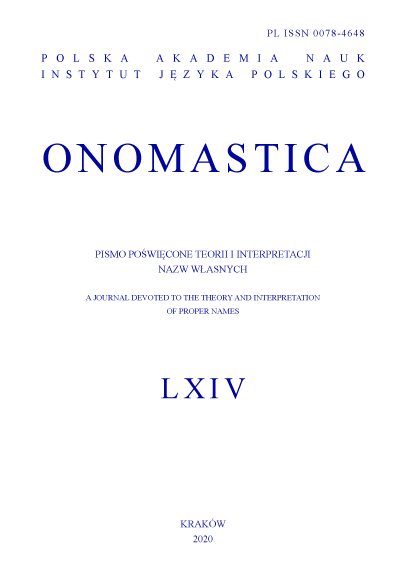Abstract
The names of stations in the Way of the Cross may be used as titles of pictures and sculptures, each corresponding to a particular event in the Passion of Christ, or as titles of meditations. The article focuses on the second meaning, but the trends of the development of both kinds of names are similar. The study is based on material consisting of about 200 texts of the service that have been published from the beginning of the 20 th century to the present (2020). The purpose of the article is to describe the changes that have taken place in the 20 th century, a period of particularly turbulent changes in religious discourse. The article deals with the function, syntactic structure and features of style, such as the use of archaic or colloquial vocabulary. These properties are considered in connection with social and cultural changes. At the beginning of the analyzed period, it was customary to use relatively long titles, which informed the participant or reader about a particular event using expressive and evaluative lexis. Those titles gradually gave way to short, schematic names. Since the Second Vatican Council, titles of a new type have appeared. Their purpose is to attract the attention of the recipient. They are based on a riddle, a contrast, allusions, etc. Therefore, the recipient derives satisfaction from deciphering the puzzle or finding the source of the quote or allusion. These phenomena are known from research on the language of press or fiction, but they can also be linked to current trends in the so-called new evangelization.
References
Breza, E. (1998). Nazwy obiektów i instytucji związanych z nowoczesną cywilizacją (chrematonimy) [Names of objects and institutions connected with modern civilization (chrematonyms)]. W: E. Rzetelska-Feleszko (red.), Polskie nazwy własne. Encyklopedia [Polish Proper Names. Encyclopaedia] (s. 343–361). Warszawa–Kraków: Instytut Języka Polskiego PAN.
Gałkowski, A. (2011). Chrematonimy w funkcji kulturowo-użytkowej. Onomastyczne studium porównawcze na materiale polskim, włoskim, francuskim [Chrematonyms in the cultural-use function. An onomastic comparative study on Polish, Italian, French material]. Łódź: Wydawnictwo Uniwersytetu Łódzkiego.
Kopeć, J.J. (1994). Droga krzyżowa, Duchowość nabożeństwa i antologia współczesnych tekstów polskich [Stations of the Cross. Spirituality of the devotion and anthology of contemporary Polish texts]. Niepokalanów: Wydawnictwo Ojców Franciszkanów.
Kosyl, Cz. (2001). Chrematonimy [Chrematonyms]. W: J. Bartmiński (red.), Współczesny język polski [Contemporary Polish Language] (s. 447–452). Lublin: Wydawnictwo UMCS.
Loewe, I. (2007). Gatunki paratekstowe w komunikacji medialnej [Paratextual genres in mass media communication]. Katowice: Wydawnictwo Uniwersytetu Śląskiego.
Makuchowska, M. (1994). Zmiany we współczesnym języku religijnym [Changes in contemporary religious language]. W: S. Gajda, Z. Adamiszyn (red.), Przemiany współczesnej polszczyzny [Changes of contemporary Polish language] (s. 107–112). Opole: Wyższa Szkoła Pedagogiczna im. Powstańców Śląskich — Instytut Filologii Polskiej.
Makuchowska, M. (1998). Etykieta w modlitwie [Etiquette in prayer]. W: S. Gajda i H. Sobeczko (red.), Człowiek — dzieło — sacrum [Human — work — sacrum] (s. 321–326). Opole: Uniwersytet Opolski — Instytut Filologii Polskiej.
Markiewicz, H. (1998). Tytuły dzieł literackich [Titles of literary works]. W: H. Markiewicz, Zabawy literackie [Literary activities] (s. 11–32). Kraków: Oficyna Literacka.
Okoniowa, J. (2007). Ideonim — pomiędzy nazwą własną a metatekstem [Ideonym — between proper noun and metatext]. W: A. Cieślikowa, B. Czopek-Kopciuch i K. Skowronek (red.), Nowe nazwy własne — nowe tendencje badawcze [New proper names — new research trends] (s. 73–79). Kraków: Wydawnictwo Pandit.
Pisarek, W. (1967). Poznać prasę po nagłówkach! Nagłówek wypowiedzi prasowej w oświetleniu lingwistycznym [Know the press by their headlines! Headlines of press texts in light of linguistics]. Kraków: Ośrodek Badań Prasoznawczych RSW „Prasa”.
Rahner, K. i Vorgrimler, H. (1987). Mały słownik teologiczny [A small theological dictionary]. Warszawa: Instytut Wydawniczy PAX.
Rutkowski, M. (2001). Wstępna charakterystyka funkcji nazw własnych [Preliminary characteristics of the functions of proper nouns]. Onomastica, 46, 7–29.
Rutkowski, M. i Skowronek, K. (2004). Media i nazwy. Z zagadnień onomastyki medialnej [Media and names. The problems of onomastics in media]. Kraków: Wydawnictwo Lexis.
Sieradzka-Mruk, A. (2014). Innowacje gatunkowe współczesnej drogi krzyżowej [Innovations in the speech genre of the contemporary Way of the Cross]. W: P. Żmigrodzki, S. Przęczek-Kisielak (red.), Bogactwo współczesnej polszczyzny [The richness of contemporary Polish language] (s. 309–316). Kraków: Towarzystwo Miłośników Języka Polskiego.
Sieradzka-Mruk, A. (2016). „Radość i nadzieja, smutek i trwoga” w nabożeństwie drogi krzyżowej. Wybrane aspekty ewolucji dyskursu religijnego w XX wieku na przykładzie leksyki dotyczącej uczuć [„The joys and the hopes, the griefs and the anxieties” in the Stations of the Cross Worship. Selected aspects of the development of religious discourse in the 20th century on the basis of vocabulary related to emotions]. Kraków: Księgarnia Akademicka.
Sieradzka-Mruk, A. (2018). Kategoria superlatywu w dawnych i współczesnych tekstach nabożeństwa drogi krzyżowej [The category of superlatives in former and new texts of the Stations of the Cross]. W: R. Przybylska, M. Rak i A. Kwaśnicka-Janowicz (red.), Historia języka, dialektologia i onomastyka w nowych kontekstach interpretacyjnych [A history of language, dialectology and onomastics in new interpretative contexts] (s. 181–189). Kraków: Wydawnictwo Uniwersytetu Jagiellońskiego.
Skowronek, K. (2000). Między Bluszczem a Cosmopolitan. Tytuły polskich czasopism kobiecych XX wieku [Between Bluszcz and Cosmopolitan. Titles of Polish magazines for women in the 20th century]. Onomastica, 45, 269–289.
Wojnowska, J. (2008). Cechy i funkcje tytułu w tekście publicystycznym na przykładzie felietonów J. Hennelowej i J. Podsiadły [Properties and functions of titles in journalistic texts on the examples of J. Hennelowa’s and J. Podsiadło’s feuilletons]. Język Polski, 88(1), 29–38.
Wojtak, M. (2004a). Gatunki prasowe [Press genres]. Lublin: Wydawnictwo UMCS.
Wojtak, M. (2004b). Styl religijny w perspektywie genologicznej [Religious style in genological perspective]. W: S. Mikołajczak, T. Węcławski (red.), Język religijny dawniej i dziś [The language of religion, past and present] (s. 104–113). Poznań: Wydawnictwo „Poznańskie Studia Polonistyczne”.


